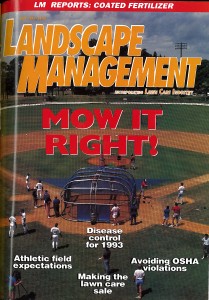
Have you ever looked up the definition of mowing?
According to Beth Baikan, Ph.D. of Cornell University, it is the “removal of photosynthetically active tissue that temporarily reduces the food-making process and weakens the plant.”
Talk about a scientific mouthful.
I favor the layman’s term version that is “cutting grass,” as I’m sure most of you and your customers do, too.
Sometimes it’s constructive to look at the practice through a technical lens, though. This is what the cover story from the May 1993 issue of Landscape Management did.
Titled “Do you know the mowing basics?” by then-editor-in-chief Jerry Roche, the story unveils what really happens when the mower blade strikes a grass blade. It communicates that through a list of the 10 most common problems caused by improper mower practices, according to Baikan
Here they are verbatim:
- At lower heights, the plant is stressed more, meaning more opportunity for weed encroachment.
- Dull blades will rip the plant, causing injury.
- When the mower is traveling at an excessive forward speed, the turf tends to show a wavy appearance.
- Mower bounce on unlevel ground contributes to an inconsistent cut.
- An improperly set deck could result in scalping, which is removing an excessive amount of leaf tissue.
- Mowing stressed grass just places more stress on the plants, resulting in a bevy of problems.
- Mowing frosted grass removes needed moisture from the plant’s access.
- Improperly maintained mowing equipment contributes to turf damage by leaking gas, oil and hydraulic fluids.
- An excessive accumulation of clippings results in an unhealthy appearance when it dries up.
- Continually mowing in the same direction causes formation of “grain.”

